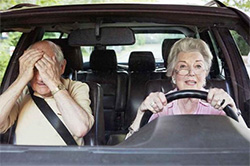
Keeping Older Drivers Safe on the Road
WATCH SEGMENT ON KFOR-TV 
According to the CDC in 2020, there were almost 48 million licensed drivers ages 65 and older in the United States. This is a 68 percent increase since 2000. Driving helps older adults stay mobile and independent. But the risk of being injured or killed in a traffic crash increases as people age. Thankfully, older adults can take steps to stay safer on the roads. Here are some recommendations by driving rehabilitation specialists that work with older drivers. Get an eye exam: Because about 90 percent of the information necessary to drive is received through our eyes, this is a good first step in ensuring your elderly parent is driving safety. So, get their eyes checked every year to be sure their vision and eyewear is up to par. Get a physical or wellness exam: As people age, it's also very important to monitor changes in overall health as it relates to driving. Medical conditions like arthritis, dementia, diabetes, Parkinson's disease, sleep apnea and stroke can all affect driving. In addition, many seniors also take multiple medications or combinations of medications that can make them drowsy or lightheaded, which can impair judgment or affect reflexes or alertness necessary for safe driving. So, an annual physical or wellness examination and medication review is also a smart way to verify driving safety. Take a refresher course: AARP and the American Automobile Association (AAA) both have older driver improvement courses that can help your parent brush up their driving skills and understand how to adjust for slower reflexes, weaker vision and other age-related physical changes that can affect driving. Taking a class may also earn them a discount on their auto insurance. To locate a class, contact your local AAA (AAA.com) or AARP (AARPdriversafety.org, 888-227-7669). Most courses cost around $20 to $30 and can be taken online. Make some adjustments: Adjusting when and where you drive is another way to help keep your parent safe and behind the wheel longer. Some simple adjustments include not driving after dark or during rush hour traffic, avoiding major highways or other busy roads, and not driving in poor weather conditions. Evaluate your driving: To stay on top of your parent's driving abilities you should take a ride with them from time-to-time watching for problem areas. For example: Does he drive at inappropriate speeds, tailgate or drift between lanes? Does he have difficulty seeing, backing up or changing lanes? Does he react slowly, get confused easily or make poor driving decisions? For more evaluation tips, AAA offers a senior driver self-rating assessment exercise (Drivers 65 Plus) that you can access at Exchange.AAA.com/safety/senior-driver-safety-mobility. If your parent needs a more thorough evaluation, you can turn to a driver rehabilitation specialist who's trained to evaluate older drivers and offer suggestions and adaptations to help keep them safe. But be aware that this type of assessment can run anywhere between $100 and $500 or more. To locate a professional in your area, visit ADED.net or AOTA.org - search "driving practitioner directory." When it gets to the point that your parent's driving isn't safe anymore and they need to quit, you may need to help them create a list of names and phone numbers of family, friends and local transportation services that he or she can call on for a ride. To find out what transportation services are available in your parent's area contact the Eldercare Locator (800-677-1116), which will direct you to their area agency on aging for assistance. |




